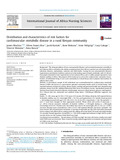| dc.description.abstract | Background
The rising prevalence of non-communicable diseases and associated premature mortality in Sub-Saharan Africa contradicts the widely accepted premise that African countries are only dominated by infectious diseases, malnutrition, maternal and child deaths. Among the non-communicable diseases, hypertension and diabetes mellitus continue to be the leading cause of death worldwide, with 10–20 million people estimated to have hypertension in Sub-Saharan Africa and 12 million people reported to have diabetes mellitus in Africa. The purpose of this study was to assess the cardiovascular–metabolic characteristics of individuals living in one rural community in Central Kenya and to propose interventions to address their needs.
Methods
A convenience sample of 262 individuals was screened/treated for cardiovascular–metabolic disease (CVMD) risk factors at a government operated community health center in Central Kenya. Self-reported estimates of physical activity, dietary intake, smoking and perceived health were obtained using questions drawn from the validated Behavioral Risk Factor Surveillance Survey. Standardized protocols (Jackson Heart Study) directed collection of physiologic measures (blood pressure, glucose, anthropometrics). Clinical data was abstracted and analyzed using Stata©. USA/Kenyan IRB/ethics approval was obtained.
Results
N = 262, mean age 54 (SD ± 17.02) years; 81% women, 99% Kikuyu ethnicity. Self-reported history of diabetes mellitus was 4%, overweight (BMI ⩾ 25) 34%, and hypertension 47%. Systolic blood pressure ⩾140 mmHg increased with age [(12%, 39%, 52%) (<45, 45–64, 65+), respectively (p ⩽ .001)]. Glucose measures indicative of diabetes mellitus (⩾126 mg/dL fasting or ⩾200 mg/dL non-fasting) were 8.3%. Women were more likely than men to be overweight (39% vs 15%) (p = <0.001) and have elevated waist circumference (30% vs 6.3%). Self-reported lifestyle risk factors included: 10% were inactive; 68% of participants consumed <3 servings of vegetables per day; 69% used solid (saturated) fat for cooking; 89% added salt to cooking [with 28% adding salt at the table]; 9% drank soda daily/weekly, 3% currently smoked cigarettes. Overall 65% (n = 170) of the sample had moderate to high risk for cardiovascular factors on the Gaziano Global Risk Score Scale.
Conclusions/recommendations
The prevalence of CVMD was high but some risk factors usually associated with CVMD were not observed. There is need for locally-tailored approaches in treatment and prevention of CVMD at the local level. | en_US |

